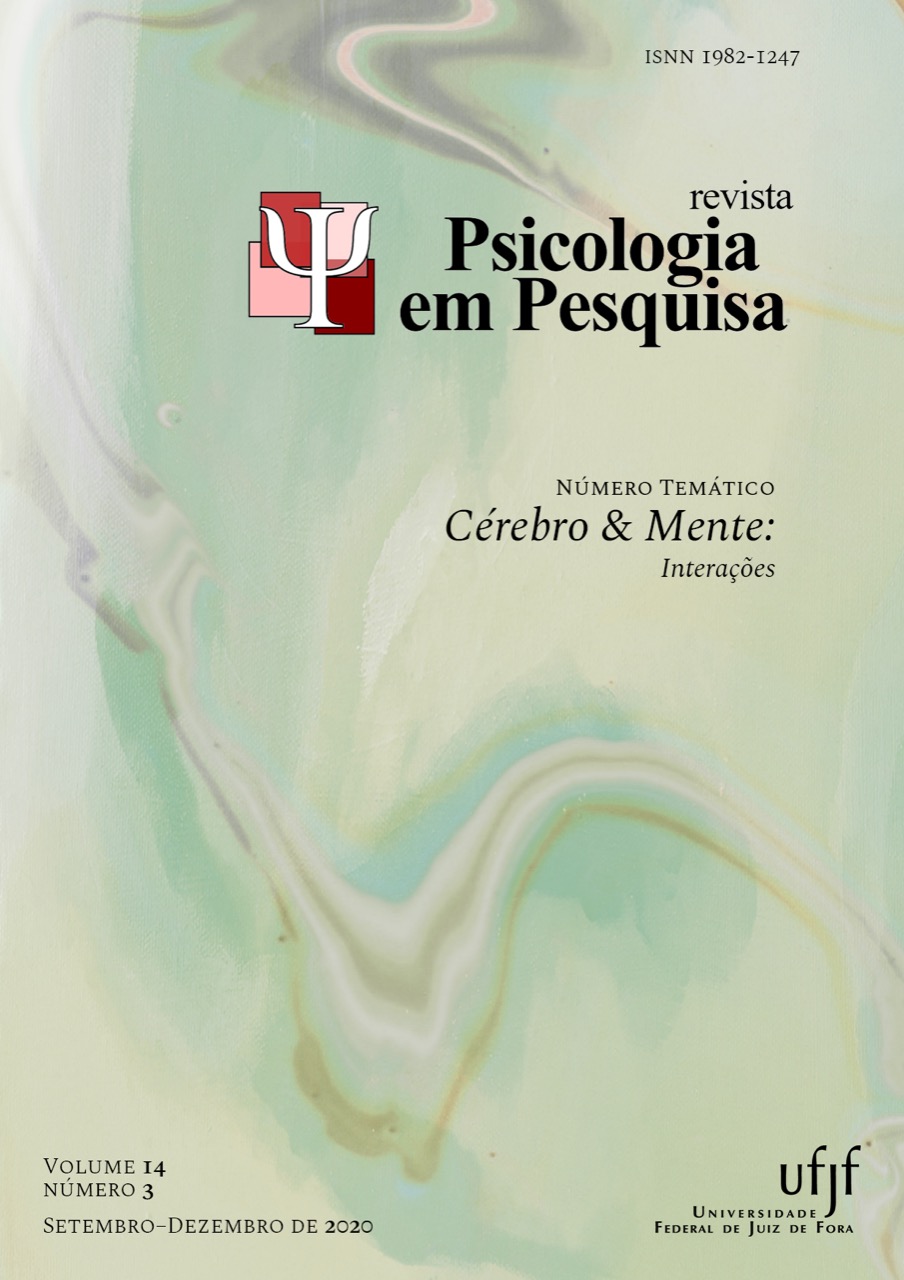Looming cue sounds
Effects on alertness and attention orientation
DOI:
https://doi.org/10.34019/1982-1247.2020.v14.30239Palavras-chave:
Auditory looming, Motion cues, AttentionResumo
Studies suggest a prioritization in the neural processing of looming sounds. A little explored issue is the relationship between this perceptual bias and the orienting and alerting auditory attention networks. The present study investigated the effect of a warning sound on the speed of response to a subsequent target sound (Experiment 1) and a possible influence of this type of cue sound on the auditory orientation of attention (Experiment 2). The results of the two experiments suggest a significant reduction in the reaction time for a subsequent target sound due to the previous presentation (500 ms) of a looming warning sound. There was no significant effect of the cue sound on auditory attention orientation.
Downloads
Referências
Bach, D. R., Neuhoff, J. G., Perrig, W., & Seifritz, E. (2009). Looming sounds as warning signals: The function of motion cues. International Journal of Psychophysiology, 74(1), 28-33. https://doi.org/10.1016/j.ijpsycho.2009.06.004
Callejas, A., Lupianez, J., Funes, M. J., & Tudela, P. (2005). Modulations among the alerting, orienting and executive control networks. Experimental Brain Research, 167(1), 27-37. https://doi.org/10.1007/s00221-005-2365-z
Card, G. M. (2012). Escape behaviors in insects. Current Opinion in Neurobiology, 22(2), 180-186. https://doi.org/10.1016/j.conb.2011.12.009
E-Prime (Version 2.0.10.248) [Computer software]. Pittsburgh, PA: Psychology Software Tools.
Ferri, F., Tajadura-Jiménez, A., Väljamäe, A., Vastano, R., & Costantini, M. (2015). Emotion-inducing approaching sounds shape the boundaries of multisensory peripersonal space. Neuropsychologia, 70, 468-475. https://doi.org/10.1016/j.neuropsychologia.2015.03.001
Fletcher, P. D., Nicholas, J. M., Shakespeare, T. J., Downey, L. E., Golden, H. L., Agustus, J. L., ... & Warren, J. D. (2015). Dementias show differential physiological responses to salient sounds. Frontiers in Behavioral Neuroscience, 9, 73. https://doi.org/10.3389/fnbeh.2015.00073
Franconeri, S. L., & Simons, D. J. (2003). Moving and looming stimuli capture attention. Perception & Psychophysics, 65(7), 999-1010. https://doi.org/10.3758/BF03194829
Hall, D. A., & Moore, D. R. (2003). Auditory neuroscience: The salience of looming sounds. Current Biology, 13(3), R91-R93. https://doi.org/10.1016/S0960-9822(03)00034-4
Johnston, S. K., Hennessey, N. W., & Leitão, S. (2019). Determinants of assessing efficiency within auditory attention networks. The Journal of General Psychology, 146(2), 134-169. https://doi.org/10.1080/00221309.2018.1541861
Kim, N. G. (2015). Perceiving collision impacts in Alzheimer's disease: the effect of retinal eccentricity on optic flow deficits. Frontiers in Aging Neuroscience, 7, 218. https://doi.org/10.3389/fnagi.2015.00218
Maier, J. X., & Ghazanfar, A. A. (2007). Looming biases in monkey auditory cortex. Journal of Neuroscience, 27(15), 4093-4100. https://doi.org/10.1523/JNEUROSCI.0330-07.2007
Maier, J. X., Neuhoff, J. G., Logothetis, N. K., & Ghazanfar, A. A. (2004). Multisensory integration of looming signals by rhesus monkeys. Neuron, 43(2), 177-181. https://doi.org/10.1016/j.neuron.2004.06.027
McCarthy, L., & Olsen, K. N. (2017). A "looming bias" in spatial hearing? Effects of acoustic intensity and spectrum on categorical sound source localization. Attention, Perception, & Psychophysics, 79(1), 352-362. https://doi.org/10.3758/s13414-016-1201-1209
McDonald, J. J., & Ward, L. M. (1999). Spatial relevance determines facilitatory and inhibitory effects of auditory covert spatial orienting. Journal of Experimental Psychology: Human Perception and Performance, 25(5), 1234-1252. https://doi.org/10.1037/0096-1523.25.5.1234
Neuhoff, J. G. (1998). Perceptual bias for rising tones. Nature, 395(6698), 123-124. https://doi.org/10.1038/25862
Neuhoff, J. G. (2001). An adaptive bias in the perception of looming auditory motion. Ecological Psychology, 13(2), 87-110. https://doi.org/10.1207/S15326969ECO1302_2
Neuhoff, J. G. (2016). Looming sounds are perceived as faster than receding sounds. Cognitive Research: Principles and Implications, 1(1), 15. https://doi.org/10.1186/s41235-016-0017-4
Neuhoff, J. G. (2018). Adaptive biases in visual and auditory looming perception. Spatial Biases in Perception and Cognition, 180-190. https://doi.org/10.1017/9781316651247.013
Orioli, G., Bremner, A. J., & Farroni, T. (2018). Multisensory perception of looming and receding objects in human newborns. Current Biology, 28(22), R1294-R1295. https://doi.org/10.1016/j.cub.2018.10.004
Pacheco-Unguetti, A. P., Acosta, A., Marqués, E., & Lupiáñez, J. (2011). Alterations of the attentional networks in patients with anxiety disorders. Journal of anxiety disorders, 25(7), 888-895. https://doi.org/10.1016/j.janxdis.2011.04.010
Petersen, S. E., & Posner, M. I. (2012). The attention system of the human brain: 20 years after. Annual Review of Neuroscience, 35, 73-89. https://doi.org/10.1146/annurev-neuro-062111-150525
Posner, M. I., & Petersen, S. E. (1990). The attention system of the human brain. Annual Review of Neuroscience, 13(1), 25-42. https://doi.org/10.1146/annurev.ne.13.030190.000325
Posner, M. I., Snyder, C. R., & Davidson, B. J. (1980). Attention and the detection of signals. Journal of Experimental Psychology: General, 109(2), 160. https://doi.org/10.1037/0096-3445.109.2.160
Posner, M. I. (2016). Orienting of attention: Then and now. The Quarterly Journal of Experimental Psychology, 69(10), 1864-1875. https://doi.org/10.1080/17470218.2014.937446
Riskind, J. H., Kleiman, E. M., Seifritz, E., & Neuhoff, J. (2014). Influence of anxiety, depression and looming cognitive style on auditory looming perception. Journal of Anxiety Disorders, 28(1), 45-50. https://doi.org/10.1016/j.janxdis.2013.11.005
Roberts, K. L., Summerfield, A. Q., & Hall, D. A. (2006). Presentation modality influences behavioral measures of alerting, orienting, and executive control. Journal of the International Neuropsychological Society, 12(4), 485-492. https://doi.org/10.1017/S1355617706060620
Sato, K., & Yamawaki, Y. (2014). Role of a looming-sensitive neuron in triggering the defense behavior of the praying mantis Tenodera aridifolia. Journal of Neurophysiology, 112(3), 671-682. https://doi.org/10.1152/jn.00049.2014
Seifritz, E., Neuhoff, J. G., Bilecen, D., Scheffler, K., Mustovic, H., Schächinger, H., ... & Di Salle, F. (2002). Neural processing of auditory looming in the human brain. Current Biology, 12(24), 2147-2151. https://doi.org/10.1016/S0960-9822(02)01356-8
Skarratt, P. A., Cole, G. G., & Gellatly, A. R. (2009). Prioritization of looming and receding objects: Equal slopes, different intercepts. Attention, Perception, & Psychophysics, 71(4), 964-970. https://doi.org/10.3758/APP.71.4.964
Skarratt, P. A., Gellatly, A. R., Cole, G. G., Pilling, M., & Hulleman, J. (2014). Looming motion primes the visuomotor system. Journal of Experimental Psychology: Human Perception and Performance, 40(2), 566. https://doi.org/10.1037/a0034456
Sturm, W., & Willmes, K. (2001). On the functional neuroanatomy of intrinsic and phasic alertness. Neuroimage, 14(1), S76-S84. https://doi.org/10.1006/nimg.2001.0839
Tajadura-Jiménez, A., Väljamäe, A., Asutay, E., & Västfjäll, D. (2010). Embodied auditory perception: The emotional impact of approaching and receding sound sources. Emotion, 10(2), 216. https://doi.org/10.1037/a0018422
von Mühlenen, A., & Lleras, A. (2007). No-onset looming motion guides spatial attention. Journal of Experimental Psychology: Human Perception and Performance, 33(6), 1297. https://doi.org/10.1037/0096-1523.33.6.1297
Wu, C. T., Weissman, D. H., Roberts, K. C., & Woldorff, M. G. (2007). The neural circuitry underlying the executive control of auditory spatial attention. Brain Research, 1134, 187-198. https://doi.org/10.1016/j.brainres.2006.11.088
Yilmaz, M., & Meister, M. (2013). Rapid innate defensive responses of mice to looming visual stimuli. Current Biology, 23(20), 2011-2015. https://doi.org/10.1016/j.cub.2013.08.015















